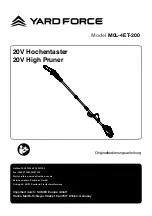
55
Saw Operations
CROWN MOLDING LYING FLAT ON
TABLE
NOTE: Position workpiece with its back flat
on the saw table.
Always place top edge of molding against
fence (decorative edge is at the bottom of
crown molding.)
“Spring angle” refers to angle between wall
and crown molding.
Cutting crown molding flat on the table can
be done either as a chop cut or a slide cut
depending on the width of the workpiece.
Refer to special auxiliary fence for narrow
cutoffs when cutting crown flat on table
(see page 57).
1.
For 90° corner, set the bevel
36
and
miter
15
angles using charts below.
Tighten the miter lock knob
12
and the
bevel lock lever
14
.
2.
Position molding on saw table. Clamp
workpiece in place using the quick
clamp
30
.
Use clamping position
that does not interfere
with operation. Before switching “ON”,
lower head assembly to make sure clamp
clears guard and head assembly.
Be aware of the path of
the saw blade. Make a
dry run with the saw Off by conducting a
simulated cutting cycle, and observe the
projected path of the saw blade. Keep
hands at least six (6) inches (152mm)
away from the projected path of the saw
blade.
3.
Follow procedures for either chop cut or
slide cut (see pages 42–43).
4.
Wait until blade comes to a complete
stop before returning head assembly to
the raised position and/or removing
workpiece.
NOTE: Always take a test cut using scrap to
confirm correct angles.
30
Crown
Molding
15
14
12
36
Fig. 58
Bevel Scale Settings
Miter Scale Settings
For 45°
Spring
Angle
For 45°
Spring
Angle
For 38°
Spring
Angle
For 38°
Spring
Angle
30
30
35
30
40
33.9
33.9
3
5
.3
3
5
.3
31
.6
31
.6
1609B06757.qxp_GCM18V-12GDC 3/25/20 12:35 PM Page 55
















































